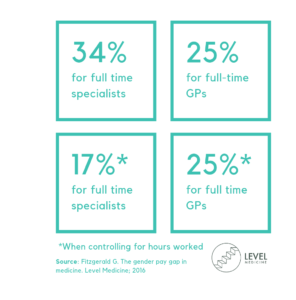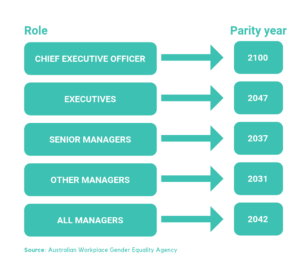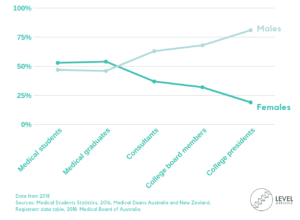Talking about gender equity can be tricky. There are lots of firmly-held beliefs in this space, and conversation can be quite emotive. There are no gold-standard ways of responding to these questions, however, the Level team has attempted to formulate answers to some of the questions we frequently encounter when talking about our work and think it might be valuable to share some of these with a broader audience.
Broadly speaking, in many parts of the world significant cultural and sociopolitical changes have afforded women a historically unprecedented degree of self-determination. To say that “women are already equal to men” may speak to a belief within a substantial proportion of society around the ways that we think people ought to be treated and allowed to participate within public and private life. In a formal sense, laws and regulations exist in Australia that explicitly forbid negative discrimination on the basis of gender. However, these beliefs and laws do not necessarily translate into practicalities, especially when we consider the stark indicators of persistent inequality all around.
- Women continue to be underrepresented in leadership roles in our society, and particularly in medicine, are also paid less than their male counterparts (for more information, see below).
- Women predominantly shoulder the burden of unpaid work, including caring for children and other domestic duties, leading to financial, professional, and personal ramifications.
- Women are still not afforded autonomy over their lives and bodies, as manifest by social norms that dictate how women should present themselves and in what circumstances they are allowed to make decisions over their physical wellbeing.
- Women experience higher rates of sexual harassment and violence in domestic spaces and in the workplace.
- The stereotypical portrayal of femininity and the role of women in society as less capable at work or more responsible at home continues to dominate popular culture and media.
- Transgender, gender-queer, and other gender-diverse people are effectively invisible in our current system, and are still routinely discriminated against, both directly and indirectly.
It is easy to assume that equality has been achieved because society has progressed to a point where opportunities are technically ‘equally’ available to both men and women. However, equality of opportunity cannot be truly achieved until we are able to appropriately overcome the unconscious bias that we continue to hold towards women. In the same vein, the end-goal of social equity should not necessarily be for everyone to have what men have right now. While we have made progress towards women and men having access to many of the same opportunities, there are pervasive forces which stand in the way of equality in a practical sense. Ongoing work is needed to dismantle the structures that privilege some human experiences and lives above others. Ultimately we want all people – regardless of gender, ethnicity, sexuality, or physical or cognitive ability – to be afforded the same opportunities in our society, by working towards a new paradigm of equality.
 There is definitely a pay gap between male and female doctors in Australia, and previous work from Level Medicine has addressed this (read more here). 2016 Australian figures demonstrate a 34% pay gap for full-time medical specialists, and a 25% pay gap among full-time general practitioners. This gap still exists when controlling for hours worked, with the annual gross personal earnings for female specialists being on average 17% less than their male counterparts, and female GPs earning on average 25% less than male GPs.
There is definitely a pay gap between male and female doctors in Australia, and previous work from Level Medicine has addressed this (read more here). 2016 Australian figures demonstrate a 34% pay gap for full-time medical specialists, and a 25% pay gap among full-time general practitioners. This gap still exists when controlling for hours worked, with the annual gross personal earnings for female specialists being on average 17% less than their male counterparts, and female GPs earning on average 25% less than male GPs.
The reasons why the pay gap exists are complex, but some of the more obvious reasons are explained here. Most of the data available regarding the pay gap has been explored in terms of a ‘male’ and ‘female’ binary, and we must acknowledge that this excludes those who do not identify within this cis-gendered binary, for whom there is currently no data available.
First, most female doctors are more junior and younger, while most senior, and hence more highly-paid, doctors are male. This is because gender parity in medical schools is taking a while to filter through the ranks, but also because women often take time off in their 20s or 30s and are then penalised for this, making it harder for them to progress to higher ranks.
Second, female doctors are less likely to work in highly-paid specialties. Only 34% of doctors with specialist registration were female as of 2018. Surgery, one of the more profitable specialties, has the least amount of women. The reasons for this are explored in more detail below.
Third, data suggests that female doctors are more likely to work fewer hours than male doctors. This is mostly because women usually bear more of the responsibility for child-rearing than men. This is another reason why it is so important to advocate for paid parental leave for all genders. However, we know that the gender pay gap is still there even when we compare hourly pay rates for doctors. For GPs, the pay gap does not change at all when adjusting for hours worked. As in many professions, female GPs with dependent children earn less than female GPs without dependent children, while male GPs with dependent children have higher earnings than male GPs who do not have dependent children.
Lastly, our current remuneration system does not work well for women and the kind of work they are more likely to do. For example, female GPs are more likely to have longer and more complex consultations, more likely to engage in preventive care, and manage more psychological and social issues. Because GPs are effectively paid per consult, having a longer consult time per patient equates to a lower pay rate compared to that of someone who can see more patients per hour. Female GPs are also more likely to spend unpaid time on patient care between consultations. Interestingly, women also prescribe fewer medications.
There also appear to be financial penalties for simply being a female doctor. Studies in Australia and abroad consistently find some degree of the pay gap among doctors cannot be explained by specialisation, hours worked, seniority, training achievements or place of employment. This implies that gender in and of itself may be a reason giving rise to pay discrepancy.
Read more about this in an article written by our wonderful former policy officer, Leah Ginnivan.
As the data pictured from 2015 would indicate, in fact there are very few specialties in which there exists a female predominance. Even for those specialties in which women do predominate, the gender balance remains closer to 50:50, including for those specialties regarded as more ‘feminine’, such as Obstetrics & Gynaecology or Paediatrics.

It’s important to understand why there are increased rates of women in certain specialty areas, especially those traditionally considered to be ‘more feminine’ or ‘softer’. Some specialties are perceived to be more flexible in training and more friendly to doctors who have caring commitments and other responsibilities outside of medicine; by both women and by men. There is also a significant gendered bias regarding ‘feminine’ specialties, with many people seeing Paediatrics – a specialty obviously focussed on children – as much more “woman friendly”. The same is true of Obstetrics and Gynaecology, though there is the additional fact that, as a specialty that focuses exclusively on female reproductive organs and childbirth, it is likely to always attract a very high level of women applicants to training.
Women are also strongly discouraged from pursuing more ‘difficult’ and ‘prestigious’ specialties ,such as Surgery, which are perceived to be incompatible with a woman’s life trajectory. Some specialties that require a high level of time commitment from their trainees and fellows also discriminate against women in their selection processes, as they are perceived to be less likely to be able to commit to full-time work.
These perceptions have at their roots very strong social biases about what work is appropriate for women to do. With over 50% of medical students being female since 2000, it should be no surprise that those career paths perceived as being “female-friendly” should get some surplus.

Assuming that we agree that we should be working towards gender parity in positions of authority, we might assume that current trajectories would be sufficient for women to have similar representation to men within the next few years. However, recent data from the Australian Workplace Gender Equality Agency would suggest otherwise, with parity across industry achieved at any point between 20-80 years away.
Within medicine, similar data suggest that, although the rates of medical students and early-career doctors are similar for men and women, there remains a significant gender discrepancy in rates of specialist practitioner registrations since 2012, and in the number of women represented in senior positions in medical colleges (the Australian College of Emergency Medicine currently has 0% female representation, as of 2019). Indeed, by using similar estimates to those provided above, if current strategies remain in place then the point of parity between men and women in specialist registration will not be reached until at least 2048.

While merit might seem like an even-handed mechanism of achieving equity, research indicates that, as long as there remains an objective imbalance in the workplace between men and women, women will be unfairly discriminated against, even in organisations that ostensibly promote meritocracy. This is because there exist unconscious biases in the way we assign positive attributes, especially to people who look, think and act like ourselves. This is the “merit trap”, and it functions not only to protect the status quo and prevent more diverse outcomes, but may also affect the quality of candidates for any particular role.
The demand for “politically correct” language can sometimes seem like an unreasonable burden, both within and beyond the workplace. However, language does matter. Work from the Diversity Council of Australia demonstrates that language is influenced by our conscious and unconscious biases, and that if we do not think about the language we use in our day-to-day conversations, individuals and groups of people can be made to feel undervalued, disrespected, or marginalised. While this may not be intentional, inclusivity involves trying to understand what another person’s perspective might be, without trivialising their experience: no one likes to feel offended, and if there are ways to avoid it by thinking more carefully about the language we use, no one need be!
Fighting for gender equity can be challenging – and this is often a burden that is placed mainly on the shoulders of those who do not identify as men. If you are a man, don’t feel like you are excluded from these conversations! It may seem like you aren’t – or ought not to be – involved, but in fact, you are in a powerful position to promote gender equity and diversity, especially among your peers who may not be open to hearing out the views of people from gender-diverse backgrounds. Here are some tips:
- Build a knowledge base about gender equity and diversity, and use this to inform your practice. It can often be easier to engage in discussion when you are offering objective, well-researched facts, particularly when talking about difficult subject matter.
- Identify as an ally. Telling people that these issues are important to you lets women and gender-diverse people know they have someone they can trust.
- Make space for women and gender-diverse voices. Make sure that their voices are heard in discussions and meetings, and speak out if you identify a lack of representation.
- Get involved by attending events about diversity and inclusion – invite your friends to come too!
- Challenge men when their behaviour perpetuates gender (or indeed any other kind of) inequity. Cis-gendered men in particular are well-placed to do this.
- Seek feedback from both men and women about your beliefs and actions. If you are not sure if something you said was offensive – ask!
- Keep an open mind if someone challenges you about something you have said or done. While your immediate reflex response might be to get on the defensive, breathe and take a moment to think about why this person is troubled by the issue at hand.
Definitely not! Level was founded by people who identify as women, and it is through that lens that we initially considered discrimination in medicine. But what we believe in and the work that we do is to ‘level’ the playing field by exploring and challenging structural discrimination in many forms. With this in mind, we believe the work Level does is for everyone, and we welcome all people to be involved.
We acknowledge that men face their own specific challenges, contributed to by firmly-held gender stereotypes. By way of example, there are medical specialties in which men are less well represented, and there are assumptions made about the capacity of men to perform well in some areas of clinical practice. Many men feel imprisoned by structures that demand particularly rigid expressions of masculine-associated traits, and expect men to hold the responsibility of being leaders and providers.
We recognise that some men in the medical workplace might, at times, feel discriminated against on the basis of any number of factors. However, this (largely) interpersonal discrimination differs in that it is not superimposed on a sociopolitical, cultural and historical bed of systemic sexism. When women are discriminated against by patriarchal power structures, they are excluded from opportunities for economic, social and political self-determination. These power structures certainly impact upon men as well, however discrimination against men bears little social, economic or political consequence to the men who are typically the beneficiaries of traditional social constructs.
In a world where those who do not identify as men continue to be paid less, experience frequent sexual harassment and violence, and are excluded from positions of power, the bulk of our work will be centred around advocating for changes to the challenges faced by women and gender-diverse people. We hope that in doing so we will chip away at the factors which might render men vulnerable to their own experiences of discrimination.
There is a lot of evidence to support the real gaps in access, pay and treatment of doctors and health professionals who identify as women, as compared to their colleagues who identify as male, but much less evidence about the extent of inequity faced by people outside this sex and gender binary. These groups experience both shared and unique professional barriers. Level Medicine is interested in and committed to addressing disparities in medicine experienced by gender-diverse people, including those who are non cisgendered, non-binary or intersex. See our work here regarding gender-diverse people and the healthcare system, including policy and practical recommendations for healthcare institutions in supporting gender-diverse patients and employees.
Individuals all across the gender spectrum are affected by firmly held stereotypes of the gender binary, by an entrenched cultural normativity, and by inflexible hierarchies that disempower individuals from speaking out. Furthermore, we believe that challenging industry and societal norms and highlighting discriminatory structures is intersectional work and has implications for addressing other axes of discrimination in medicine.
Level Medicine strongly believes that addressing other forms of structural discrimination including racism, ableism, classism and discrimination based on sexuality are all critical in changing the culture of medicine and creating an industry that better reflects and supports the diverse society it should serve. Having said this, we have deliberately chosen to focus on gender disparity as we feel this is a realistic and achievable goal. As an extension of our work we aim to create support professional environments in medicine, particularly regarding pay transparency, parent leave and and flexible training. We also cover diversity and inclusion more broadly in our workshop program, as we aim to approach gender equity in an intersectional manner.
We certainly recognise that there are different contributors to a person’s privilege, and doctors have a significant amount of social, educational and financial privilege. We believe that there is value in creating a professional environment that reflects broader values we strive for. With the power that doctors have comes potential for influence in various areas, including research, policy, and institutional practice. It is our hope that by addressing the barriers to creating a professional cohort which is diverse and reflective of broader society, we can improve the healthcare experienced by Australians more broadly.
Are there questions you frequently come up against when advocating for gender equity in your own place of work or study? Feel free to get in touch with us at [email protected] and we’ll help you nut out a response.
Contributors: Josephine De Costa, Imogen Janus, Joshua Gold, Maddie Otto, Grace Fitzgerald, Meredith Grey.
